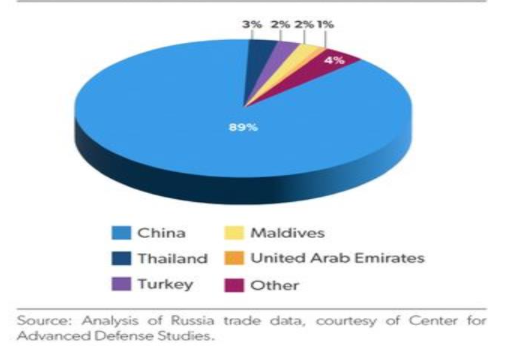The sanctions imposed by the United States, which aimed to disrupt Russia’s military capabilities by limiting its access to advanced chips are only having limited results. While Russian entities can no longer get chips directly from American, European, Japanese, and Taiwanese companies, Russia continues to obtain advanced processors mainly through indirect channels, primarily involving Chinese distributors, who now control 89% of the market, according to a report from the American Enterprise Institute.
However, prices have risen. Russia pays nearly double for semiconductors compared to pre-war prices due to the need to establish new supply chains, with prices at US$1,411 per kilogram of chips in 2021, rising to US$2,730 per kilogram in 2023.
Chinese distributors have continued to supply Russian buyers with chips after Western companies and countries cut their ties with Russia. This process circumvents direct sales bans by routing the transactions through China, where enforcement of US sanctions largely disregarded, thus maintaining a steady flow of technology into Russia.
Additionally, Russia employs transshipment strategies involving other nations, such as Turkiye and the United Arab Emirates, which act as intermediate points for high-tech deliveries. Entities in these countries receive the initial shipments and then forward them to Russia, complicating the enforcement of export controls. Traders will always find ways to trade.
Before the sanctions, Russia sourced its semiconductors through three major avenues: direct imports from Western companies, which includes both direct imports by companies like AMD and Intel as well as sales by major distributors, such as Ingram Micro; Russian-designed chips manufactured abroad, primarily by TSMC; and a small domestic production mainly serving the defense sector. Post-sanctions, direct imports have been severely restricted except for covert routes through countries like China and possible secret manufacturing agreements with Chinese contract makers of chips, such as SMIC and Hua Hong.
Sources of Chips Exported To Russia

Meanwhile, AEI claims that Russian domestic chip manufacturing remains way too outdated and is limited to serving the defense industry. Manufacturers like Angstrem and Micron are heavily reliant on outdated wafer fab tools produced in America and Europe, which is why they have struggled to increase production in the face of sanctions that cut off their access to essential foreign equipment and materials. However, Russia has managed to obtain some wafer fab tools from countries known to be U.S. allies.
The AEI report advocates for a new, multilateral export control regime that includes strengthened enforcement mechanisms and recommends involving all U.S. allies to ensure a more cohesive and effective approach to semiconductor export controls. Meanwhile, China is not exactly a U.S. ally but remains a major trade partner. The difficulty is in the sheer dynamics and possibly an overstating of the Wests case: only a handful of nations – primarily the G7 – have actually imposed sanctions on Russia. The vast majority of countries have not, and of those, about half – or 80 nations actively seek trade with Russia. With mechanisms such as BRICS, and the introduction of tailored trade dynamics such as energy for chips, the hindering of Russian imports to an extent that it truly has the effects originally intended look increasingly difficult for the West to accomplish. While it is true that Russia has a deficit of domestic chip producers, this remains a country capable of space exploration at the cutting edge of science and it can only be a matter of time before Russia catches up, especially as President Putin has directed the Russian economy to become self-sustainable in key manufacturing areas – including microchips.




